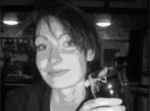
sinks into chaos
pictures falling angels
encounters the early
poems
on
wonder
makes heavenly
music
tackles Satan's
rhetoric
crosses
the shades of death
on the
long road ahead
hears the call of
Lycidas
on
Milton's soaring Muse

sympathises with Sin
searches out new
worlds

|
MEET THE CONTRIBUTORS
We asked all of our contributors to tell us about their favourite lines of Milton and their experiences of reading his work.
Beth Sims
The one seemed woman to the waist, and fair,
But ended foul in many a scaly fold
Voluminous and vast, a serpent armed
With mortal sting: about her middle round
A cry of hell hounds never ceasing barked
With wide Cerberean mouths full loud, and rung
A hideous peal: yet, when they list, would creep,
And kennel there, yet there still braked and howled
Within unseen.
~Paradise Lost, II.650.
Sin is, for me, the most arresting female character in Paradise Lost. This is despite, and in a way because of, the brevity of her appearance. Satan encounters Sin only once, at the Gates of Hell, and our short glimpse is of an enigmatic 'snaky sorceress' (II.724). Sin is enchanting because she is something different and apart from the demonic fallen angels. She wields a significant amount of power, as the guardian of the key that can unlock Hell for Satan. Sin is not a grisly male beast but a rare female presence in a male-dominated space. She literally and metaphorically offers the possibility of an escape from the testosterone-driven bravado of Hell's other inhabitants.
And yet, we cannot even be entirely certain that Sin is a 'she', despite the clues that would usually allow us to conclude that Sin is categorically female. Sin is called 'daughter' (II.817, 870) and has a womb, but her gender is not straightforward. Whilst Sin is feminine, she is only 'woman to the waist'. She appears, like a mermaid, or like a Barbie doll, to have no genitalia. How can we then be certain that she is female? It is an assumption which comes with gendered language. Also, Sin gives birth ceaselessly, like a queen bee: 'yelling monsters' (II.795) are 'hourly conceived | And hourly born' (II.796) from her. These creatures violently burst out of her, possibly because there is no opening to Sin's womb. This is a disgusting and bizarre process to imagine. It is also important that Sin is Satan's daughter. The moral discomfort we feel over their incestuous relationship is heightened by provoking visceral reactions of repulsion in the reader with this kind of imagery.
It seems unnatural that every birth breaks Sin open. Sin is constantly forced to change form and we are left uncertain about who or what Sin really is. Because we only see a moment in Sin's process of transformation, our appetite is whetted to know the extent of her variety. Sin is a character in flux and it is difficult to tell whether the form of Sin that we have witnessed will remain constant for any length of time. She is also in an incessant turmoil which is made more fascinatingly complex by her possession of the key. Her position of being a guardian seems to put her in control, but as she continues to breed and 'unlock' Satan's demonic creatures, she remains in the service of Satan, and so is very much out of it. Sin will not stay still for a portrait and this elusiveness makes the character more intriguing.
|

Writer, Design Assistant.
Beth is enjoying her second year as an English student at Christ's. Her favourite writer is Angela Carter. She passionately likes to design for theatre, and loves costume in particular, working for various drama societies in Cambridge as well as some London-based companies, with a view to a career as a costumier in the West End. At the time of writing, she is reading for the new term, doing a shop job, working on Cymbeline for the Cambridge Arts Theatre, listening to the Puppini Sisters and dressing-up at every available opportunity.
Characters - Sin and Death
Characters - Adam and Eve
Plot Summary: Book I
|


